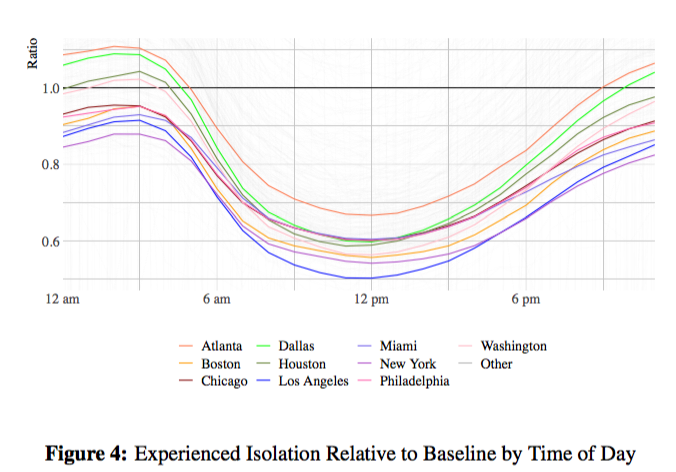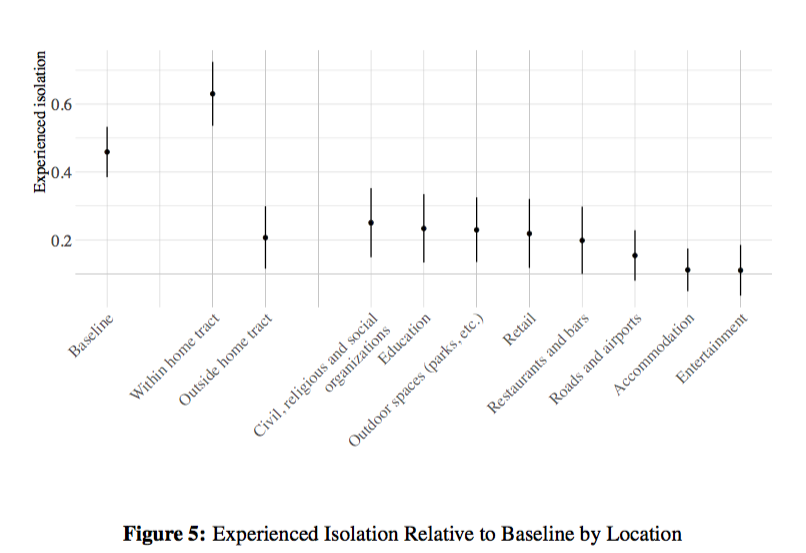We’re much less segregated during the day, and when we’re away from home
Commercial and public spaces are important venues for interaction with people from other racial/ethnic groups
Patterns of experienced segregation tend to mirror residential segregation across metro areas.
In the US, we measure racial and ethnic segregation using census data that reports where we live. For example, the rankings of white/non-white segregation in US metro areas that we reported last month are based on residential data from the American Community Survey. But looking just at where we live (or sleep) doesn’t tell us everything about segregation. Some worry that while we may live near each other, we don’t spend a lot of time with people from other racial/ethnic groups. Indirect measures—like the extent of interracial marriage—confirm that less segregated places do have more inter-group interaction, where and when that kind of interaction happens outside of residential neighborhoods has been a bit of mystery—until now.
A new paper from economists Susan Athey, Billy Ferguson, Matthew Gentzkow and Tobias Schmidt uses anonymized cell-phone data to look at patterns of racial segregation in US metro areas over the course of the day and in different locations. We may live in different neighborhoods, but do our daily activities, like working, shopping, dining and entertaining, cause use to be less segregated? Their answer is a definite yes.
Athey, et al, use a “isolation index” to measure the extent to which white and non-white persons interact with one another over the course of the day. Also, because their underlying data is anonymized, they can’t directly observe the race/ethnicity of individuals, and so rely on census data on the race and ethnicity of their neighborhoods (actually, census blocks) to classify observations. Consequently, their results are best thought of as showing the extent to which people who live in predominantly white neighborhoods interact with people who live in predominantly non-white neighborhoods in different places and at different times of the day.
The paper’s key insight is a new and broader computation of the lived, or in their words “experienced” level of segregation in US cities over time and space. As a rule, we’re less segregated over the course of our daily routines than we are when we’re at home. As with conventional measures of residential segregation, there are wide variations across cities, with some cities much more segregated than others.
Segregation by Time of Day and Place
The cell-phone data allow the authors to compute the isolation index by time of day, and it turns out we’re most isolated from one another (by race and ethnicity) when we’re in our homes. Over the course of the day, though, we’re much more likely to interact with people from different racial/ethnic groups. The following chart plots the hourly variation in the experienced isolation index relative to the residential isolation index for large cities. Higher levels indicate more segregation. The data show a consistent pattern across cities, with isolation being highest overnight, dropping during the morning. Mixing peaks at about Noon, and declines thereafter. At midday, people are about 40 percent less segregated than they are overnight.
The cellphone data also enable the authors to compute isolation indexes for different kinds of locations. As noted home locations tend to have the highest levels of isolation, but many commercial and social settings produce much higher levels of mixing (lower levels of isolation).
The cell phone data allows the authors to look at a variety of destinations. In general all of the locations (schools, parks, retail, restaurants, bars, entertainment) are broadly similar. Accommodations and entertainment seem to have the greatest levels of intergroup mixing.
Which metros have the lowest levels of segregation?
Athey, et al look at the patterns of isolation across metropolitan areas and compare them to common measures of residential segregation. The following table shows their estimates of experienced segregation for metro areas with a population of 1 million or more. Metro areas are ranked according to the isolation index, with the least segregated (lowest scores) first, and most segregated (highest scores) last.
Similar to a ranking of segregation in the central urban counties of the nation’s large metropolitan areas that we published last month at City Observatory, Portland has the lowest level of both residential and experienced segregation of any large US metro area, followed by Seattle, Minneapolis, Raleigh and San Francisco. The cities with the highest levels of experienced segregation include Milwaukee, Detroit and St. Louis.
Experienced segregation largely mirrors residential segregation.
In general, cities with high levels of residential segregation also tend to have higher levels of experienced segregation. The following chart shows the relationship between residential segregation (on the vertical axis) and experienced segregation (on the horizontal axis). There’s a strong positive correlation between the two types of segregation (with experienced segregation being considerably less than residential segregation in most metropolitan areas.
The Athey, et al, research has important implications for thinking about how we can more quickly foster more integrated communities. Because we move to different housing relatively infrequently, and because housing markets change even more slowly, changing patterns of residential segregation take time. But the fact that we already have higher levels of intergroup exposure in a range of public and commercial spaces suggests that they may be easier and more fruitful opportunities to promote integration. As the author’s explain:
People spend substantial time away from their home neighborhoods, and when they do they are much more likely to encounter diverse others than they would at home. Commercial places like restaurants and retail shops are a particularly strong force pulling against segregation, while local amenities such as churches and schools tend to remain more segregated. One implication is that public goods that are tied to residential boundaries should be a particular focus of efforts to combat segregation.
Susan Athey, Billy A. Ferguson, Matthew Gentzkow, and Tobias Schmidt, Experienced Segregation, Working Paper 27572 http://www.nber.org/papers/w27572


